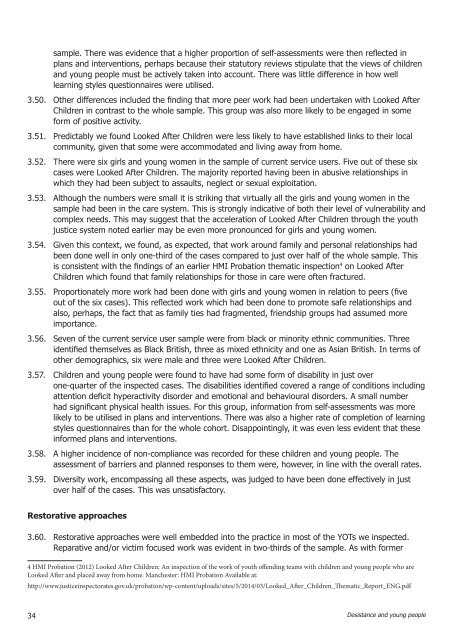Desistance and young people
Desistance_and_young_people
Desistance_and_young_people
You also want an ePaper? Increase the reach of your titles
YUMPU automatically turns print PDFs into web optimized ePapers that Google loves.
sample. There was evidence that a higher proportion of self-assessments were then reflected in<br />
plans <strong>and</strong> interventions, perhaps because their statutory reviews stipulate that the views of children<br />
<strong>and</strong> <strong>young</strong> <strong>people</strong> must be actively taken into account. There was little difference in how well<br />
learning styles questionnaires were utilised.<br />
3.50. Other differences included the finding that more peer work had been undertaken with Looked After<br />
Children in contrast to the whole sample. This group was also more likely to be engaged in some<br />
form of positive activity.<br />
3.51. Predictably we found Looked After Children were less likely to have established links to their local<br />
community, given that some were accommodated <strong>and</strong> living away from home.<br />
3.52. There were six girls <strong>and</strong> <strong>young</strong> women in the sample of current service users. Five out of these six<br />
cases were Looked After Children. The majority reported having been in abusive relationships in<br />
which they had been subject to assaults, neglect or sexual exploitation.<br />
3.53. Although the numbers were small it is striking that virtually all the girls <strong>and</strong> <strong>young</strong> women in the<br />
sample had been in the care system. This is strongly indicative of both their level of vulnerability <strong>and</strong><br />
complex needs. This may suggest that the acceleration of Looked After Children through the youth<br />
justice system noted earlier may be even more pronounced for girls <strong>and</strong> <strong>young</strong> women.<br />
3.54. Given this context, we found, as expected, that work around family <strong>and</strong> personal relationships had<br />
been done well in only one-third of the cases compared to just over half of the whole sample. This<br />
is consistent with the findings of an earlier HMI Probation thematic inspection 4 on Looked After<br />
Children which found that family relationships for those in care were often fractured.<br />
3.55. Proportionately more work had been done with girls <strong>and</strong> <strong>young</strong> women in relation to peers (five<br />
out of the six cases). This reflected work which had been done to promote safe relationships <strong>and</strong><br />
also, perhaps, the fact that as family ties had fragmented, friendship groups had assumed more<br />
importance.<br />
3.56. Seven of the current service user sample were from black or minority ethnic communities. Three<br />
identified themselves as Black British, three as mixed ethnicity <strong>and</strong> one as Asian British. In terms of<br />
other demographics, six were male <strong>and</strong> three were Looked After Children.<br />
3.57. Children <strong>and</strong> <strong>young</strong> <strong>people</strong> were found to have had some form of disability in just over<br />
one-quarter of the inspected cases. The disabilities identified covered a range of conditions including<br />
attention deficit hyperactivity disorder <strong>and</strong> emotional <strong>and</strong> behavioural disorders. A small number<br />
had significant physical health issues. For this group, information from self-assessments was more<br />
likely to be utilised in plans <strong>and</strong> interventions. There was also a higher rate of completion of learning<br />
styles questionnaires than for the whole cohort. Disappointingly, it was even less evident that these<br />
informed plans <strong>and</strong> interventions.<br />
3.58. A higher incidence of non-compliance was recorded for these children <strong>and</strong> <strong>young</strong> <strong>people</strong>. The<br />
assessment of barriers <strong>and</strong> planned responses to them were, however, in line with the overall rates.<br />
3.59. Diversity work, encompassing all these aspects, was judged to have been done effectively in just<br />
over half of the cases. This was unsatisfactory.<br />
Restorative approaches<br />
3.60. Restorative approaches were well embedded into the practice in most of the YOTs we inspected.<br />
Reparative <strong>and</strong>/or victim focused work was evident in two-thirds of the sample. As with former<br />
4 HMI Probation (2012) Looked After Children: An inspection of the work of youth offending teams with children <strong>and</strong> <strong>young</strong> <strong>people</strong> who are<br />
Looked After <strong>and</strong> placed away from home. Manchester: HMI Probation Available at:<br />
http://www.justiceinspectorates.gov.uk/probation/wp-content/uploads/sites/5/2014/03/Looked_After_Children_Thematic_Report_ENG.pdf<br />
34 <strong>Desistance</strong> <strong>and</strong> <strong>young</strong> <strong>people</strong>


